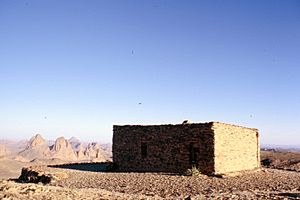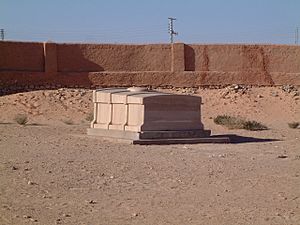Charles de Foucauld facts for kids
Quick facts for kids SaintCharles de Foucauld |
|
|---|---|

Circa 1907
|
|
| Born | 15 September 1858 Strasbourg, Second French Empire |
| Died | 1 December 1916 (aged 58) Tamanrasset, French Algeria |
| Venerated in | Catholic Church Anglican Communion |
| Beatified | 13 November 2005, Saint Peter's Basilica, Vatican City by Cardinal José Saraiva Martins |
| Canonized | 15 May 2022, Saint Peter's Square, Vatican City by Pope Francis |
| Feast | 1 December |
| Attributes | white religious habit with the Sacred Heart of Jesus, crowned with a cross |
Charles Eugène, vicomte de Foucauld de Pontbriand, (born September 15, 1858 – died December 1, 1916), known as Charles de Foucauld, was a French soldier, explorer, and Catholic priest. He became a hermit and lived among the Tuareg people in the Sahara desert in Algeria. He was killed in 1916.
His life and writings inspired many religious groups. These groups, like the Little Brothers of Jesus, follow his example. He was made a saint by the Catholic Church in 2022.
Charles de Foucauld became an orphan at age six. His grandfather, Colonel Beaudet de Morlet, raised him. He trained to be an officer at the Saint-Cyr Military Academy. After graduating, he joined the cavalry. He became a priest in 1901 and settled in the Algerian Sahara at Béni Abbès. He hoped to start a new religious community, but no one joined him at first. He took the religious name Charles of Jesus. He lived with the Berbers, showing his faith through his actions, not just words.
On December 1, 1916, Charles de Foucauld was killed at his hermitage. Many people quickly saw him as a martyr for his faith. His story became well-known after a book about his life was written. New religious groups and ways of life were inspired by him. The process to make him a saint began in 1927. He was declared "Venerable" in 2001 by Pope John Paul II. He was then declared "Blessed" in 2005 by Pope Benedict XVI. In 2020, the Vatican announced that a miracle was linked to his prayers. Pope Francis made him a saint on May 15, 2022, in Rome.
Contents
Biography
Early Life
Charles de Foucauld's family came from the Périgord region of France. They were part of the old French nobility. Their family motto was "Never behind." Some of his ancestors took part in the crusades. This was a source of pride for his family.
His mother, Élisabeth de Morlet, was from a noble family in Lorraine. She married Édouard de Foucauld de Pontbriand in 1855. Their first son, Charles, was born in 1857 but died a month later. Their second son, Charles Eugène, was born in Strasbourg on September 15, 1858.
In 1861, his sister, Marie, was born. His mother taught him about the Catholic faith. She died in March 1864, and his father died in August of the same year. Charles, at age 6, and Marie, at age 3, became orphans. Their maternal grandparents, Colonel Beaudet de Morlet and his wife, took them in. Charles loved his grandfather, who was very kind and intelligent.
Charles went to school in Strasbourg. He was often sick and had private lessons. In 1868, he spent the summer with his aunt, Inès Moitessier. His cousin, Marie Moitessier, became a close friend. She was like a mother figure to him.
In 1870, his family moved to Bern, Switzerland, because of the Franco-Prussian War. After France lost the war, they moved to Nancy in 1871. Charles continued high school there. He became very patriotic and did not trust the German Empire. He received his First Communion in 1872.
Around age 15, he started to question his faith. He later said he spent many years not believing in God. This made him feel lost and selfish. In 1874, he finished high school with good grades.
Military Training and Exploration
Charles went to the Sainte-Geneviève school in Paris. He was preparing for the Saint-Cyr Military Academy. He found the boarding school strict and stopped practicing his religion. He was asked to leave the school in 1876 for being "lazy and undisciplined."
He returned to Nancy and continued his studies. He wanted to "enjoy everything that is pleasant to the mind and body." He read many famous books. In June 1876, he was accepted into the Saint-Cyr Military Academy. He was one of the youngest students. He graduated lower in his class.
After his grandfather died, Charles received a large inheritance. He then went to the French cavalry school at Saumur. He continued to enjoy a fun lifestyle. He was sent to Algeria with the 4th Regiment of Chasseurs d'Afrique. He found military life boring. He traveled in Morocco (1883–84), the Sahara (1885), and Palestine (1888–89).
When he was in Paris, he lived like a wealthy young person. But in Algeria, he became a serious student of geography and culture. He learned a lot about Algeria and Morocco. In 1885, a geography society in Paris gave him a gold medal for his explorations.
A Life of Faith
On January 14, 1890, Charles de Foucauld joined the Trappist monastery of Abbey of Notre-Dame des Neiges. He took the name Marie-Albéric. After a few months, he was sent to a Trappist abbey in Akbès, near the Syrian-Turkish border. Even though the Trappists lived a very simple life, Charles felt that the people in nearby villages were even poorer.
In 1897, after seven years, he left the Trappist order. He went to Nazareth and lived a life of prayer near a convent of Poor Clares. He worked there as a porter and servant. Later, he was encouraged to become a priest. He returned to Akbès to prepare. On June 9, 1901, at age 43, he became a priest in Viviers, France.
After becoming a priest, he went to the Sahara in French Algeria. He continued to live like a hermit. He took the religious name Charles of Jesus. He first settled in Béni Abbès, near the Moroccan border. He built a small hermitage for prayer and welcoming people. He called it the "fraternity" and called himself and future members "little brothers" of Jesus.
De Foucauld later moved to live with the Tuareg people in Tamanghasset, in southern Algeria. This area is in the central Sahara, near the Ahaggar Mountains. He used the highest point in the region, the Assekrem, as a place for quiet prayer. He lived closely with the Tuareg people, sharing their lives and challenges. He spent ten years studying their language and culture. He created a dictionary and grammar for the Tuareg language. His dictionary was published after his death and is very important for people who study Berber languages.
Death
On December 1, 1916, Charles de Foucauld was taken from his hermitage by a group of tribal raiders. They wanted to kidnap him. Two French soldiers on camels arrived and interrupted them. One bandit, a 15-year-old named Sermi ag Thora, shot Charles de Foucauld, killing him instantly. The soldiers were also killed. Charles de Foucauld's servant, Paul Embarek, saw what happened. The Tuareg people buried him the next morning, showing their friendship with him.
French authorities searched for the bandits for many years. In 1944, Sermi ag Thora was caught and executed. In April 1929, Charles de Foucauld's remains were moved to a tomb in the cemetery of St. Joseph in El Meniaa.
Becoming a Saint
Charles de Foucauld was declared "Blessed" by Cardinal José Saraiva Martins on November 13, 2005. This was done on behalf of Pope Benedict XVI.
On May 27, 2020, Pope Francis approved a second miracle linked to Charles de Foucauld. This meant he could become a saint. On March 4, 2022, the date for his canonization ceremony was set for May 15, 2022. His feast day is on December 1.
Religious Groups Inspired by Charles de Foucauld
Charles de Foucauld inspired and helped start a group in France to support his ideas. This group was called the Association of the Brothers and Sisters of the Sacred Heart of Jesus. It had 48 members when he died. Members of this group, like Louis Massignon and René Bazin, kept his memory alive. They inspired many families of religious groups. These groups started in France but are now found all over the world. The Charles de Foucauld Spiritual Family Association includes the Little Brothers of Jesus, the Little Sisters of Jesus, and 18 other religious orders. These groups for priests, religious, and laypeople were all inspired by him.
| Type of community | Name of community (year of foundation) | ||
|---|---|---|---|
| Mixed | For men | For women | |
| Associations of the faithful |
|
— |
|
| Religious institutes | — |
|
|
| Societies of apostolic life | — |
|
— |
| Secular institutes |
|
— |
|
Legacy
The 1936 French film The Call of Silence showed his life story.
The 1941-42 class of the Saint-Cyr military academy in France was named after him.
In 1950, the Algerian government issued a postage stamp with his picture. The French government did the same in 1959.
Antonello Padovano wrote and directed a film called "The Four Doors of the Desert." It is about Charles de Foucauld's life and his friendship with the Tuareg leader Moussa Ag Amastan.
Charles de Foucauld is honored in the Church of England and the Episcopal Church on December 1.
Works
- Reconnaissance au Maroc, 1883–1884. 4 vols. Paris: Challamel, 1888.
- Dictionnaire Touareg–Français, Dialecte de l'Ahaggar. 4 vols. Paris: Imprimerie nationale de France, 1951–1952.
- Poésies Touarègues. Dialecte de l'Ahaggar. 2 vols. Paris: Leroux, 1925–1930.
See also
 In Spanish: Carlos de Foucauld para niños
In Spanish: Carlos de Foucauld para niños



